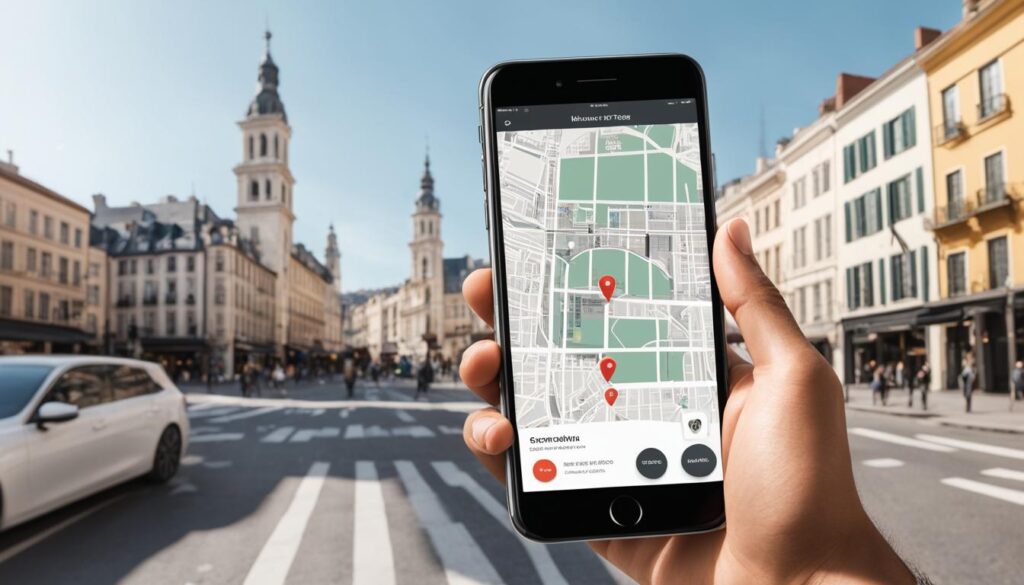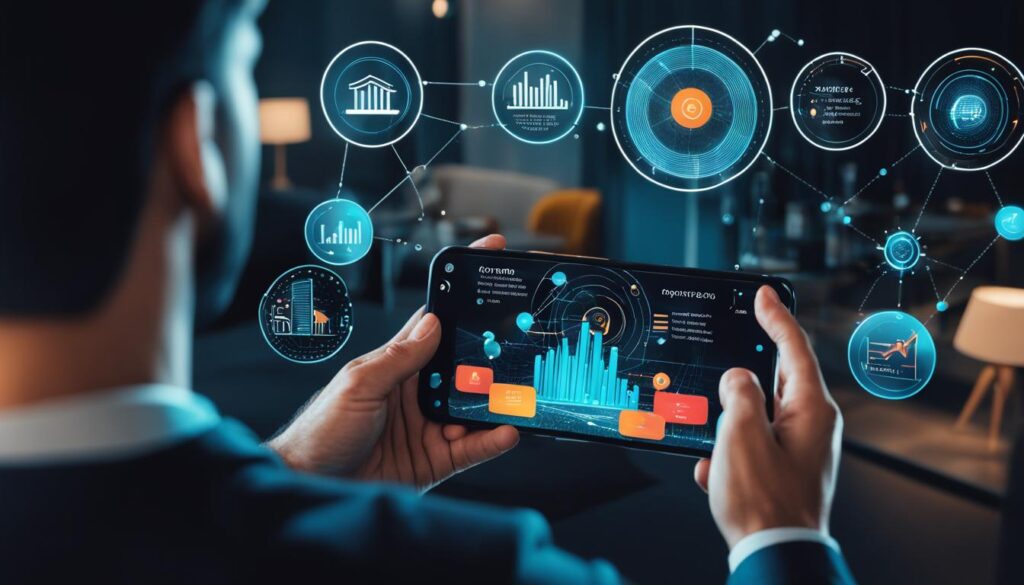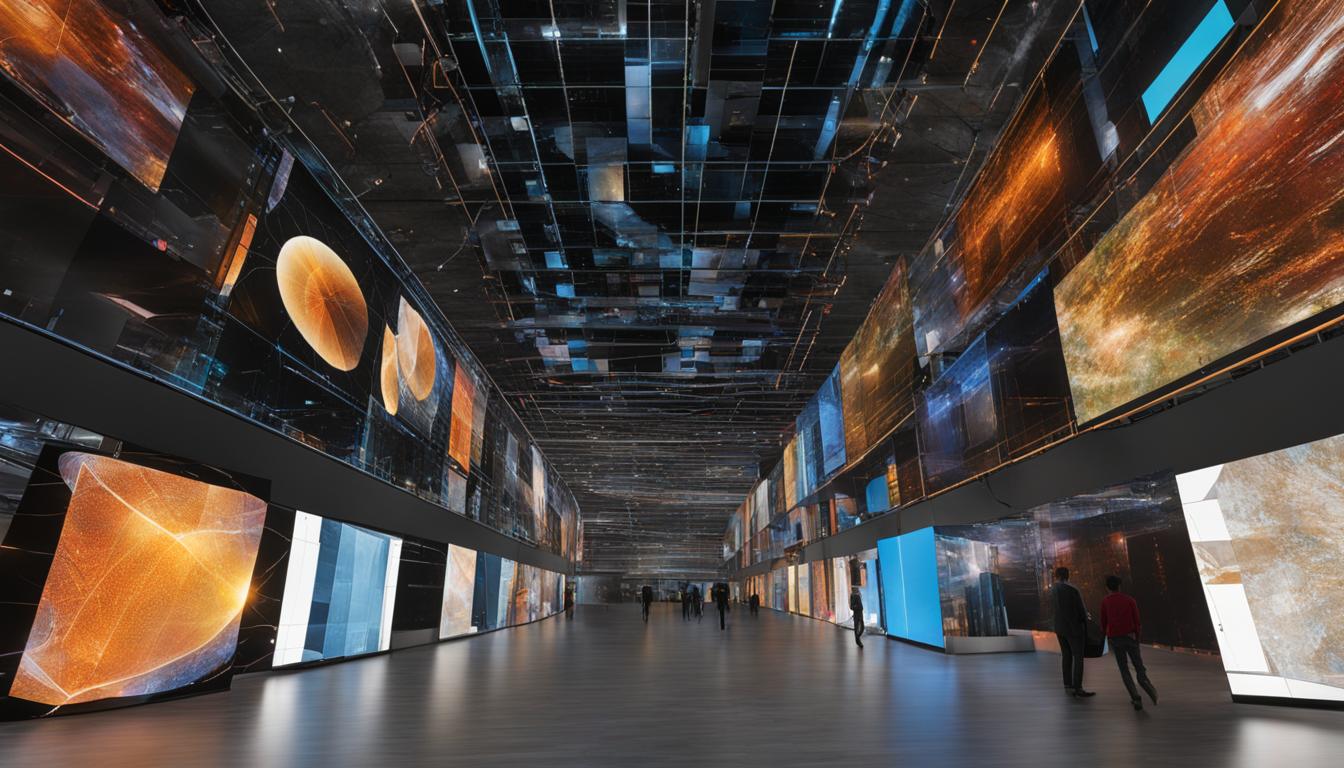Augmented reality (AR) has revolutionized our interaction with digital content and the physical world. By seamlessly blending virtual elements with reality, AR provides immersive experiences that enhance productivity, entertainment, and decision-making processes.
But have you ever wondered what kind of data fuels the magic of augmented reality? Let’s dive in and explore the various data types that AR relies on to create these cutting-edge experiences.
Contents
- 1 Sensors and Environmental Data
- 2 User Input and Interaction Data
- 3 Real-time Data Integration
- 4 Contextual and User Profile Data
- 5 Analytics and Performance Data
- 6 Conclusion
- 7 FAQ
- 7.1 What kind of data does augmented reality (AR) use?
- 7.2 What are the sensors and environmental data used in augmented reality?
- 7.3 How does augmented reality collect user input and interaction data?
- 7.4 What is spatial mapping and object recognition data in augmented reality?
- 7.5 How does real-time data integration work in augmented reality?
- 7.6 What is the role of contextual and user profile data in augmented reality?
- 7.7 How are analytics and performance data used in augmented reality?
- 7.8 How does augmented reality utilize data to unlock its full potential?
- 8 Source Links
Key Takeaways:
- Augmented reality utilizes a variety of data types to enhance user experiences and provide valuable insights.
- Sensors, such as cameras, accelerometers, GPS, and compasses, capture environmental data and enable AR to overlay digital content in the real world.
- User input and interaction data, including gestures, voice commands, and touch interactions, enhance the interactivity of AR experiences.
- Spatial mapping and object recognition technology enable AR systems to place virtual content in the physical environment accurately.
- Real-time data integration keeps AR experiences dynamic and responsive by overlaying up-to-date information on the user’s view.
Sensors and Environmental Data
Augmented reality (AR) relies on various sensors to detect environmental conditions and gather data, enabling immersive and interactive experiences.
These sensors capture and process real-time information, bridging the physical world and digital overlays.
The sensors used in AR applications include:
- Cameras: These sensors capture visual information from the user’s surroundings, allowing AR systems to overlay digital content seamlessly. They perceive the natural world and enable the integration of virtual objects or data.
- Accelerometers: These sensors measure movement, orientation, and acceleration. By detecting changes in movement, accelerometers enable AR applications to respond dynamically to physical interactions, enhancing the user’s immersion and engagement.
- GPS: Global Positioning System (GPS) sensors provide location data, allowing AR systems to incorporate geospatial information into the virtual experience. This data enables location-based overlays and contextually relevant content.
- Compasses: Compass sensors detect the device’s orientation, allowing AR applications to align the digital content with the user’s perspective. This ensures an accurate and synchronized overlay of virtual objects onto the real world.
By combining the inputs from these sensors, augmented reality seamlessly integrates digital elements into the user’s environment.
This convergence of digital and physical realms opens up endless entertainment, education, productivity, and more possibilities.
The following table provides a summary of the sensors used in augmented reality:
| Sensor | Function |
|---|---|
| Cameras | Capture visual information for overlaying digital content |
| Accelerometers | Measure movement, orientation, and acceleration |
| GPS | Provide location data for geospatial overlays |
| Compasses | Detect device orientation for accurate overlay alignment |
These sensors enable augmented reality to blend digital content seamlessly with the user’s physical surroundings. By leveraging environmental data, AR applications create engaging, informative, and personalized experiences that enhance various aspects of our lives.
Also read: Can we upload Pictures to Augmented Reality on iPad?
User Input and Interaction Data
In augmented reality, user input and interaction data are crucial in creating immersive and interactive experiences. AR systems use various input methods to capture and interpret user commands, gestures, and interactions.
By tracking these inputs, augmented reality can adapt and respond to user actions, enhancing the overall user experience.
AR user input can take different forms, including:
- Gestures: Users can interact with AR content through hand gestures, such as swiping, tapping, or pinching. These gestures allow users to manipulate virtual objects, navigate digital environments, and perform actions like resizing or rotating.
- Voice commands: AR systems can be controlled using voice commands, enabling hands-free interaction. Users can issue commands to trigger specific actions, manipulate virtual objects, or access information within the AR environment.
- Touch interactions: Touch screens or touch-sensitive devices allow users to interact directly with AR content. Users can tap, drag, or swipe on the screen to interact with virtual objects and menus, providing a tactile experience.
- Gaze tracking: Some AR systems use eye-tracking technology to detect and analyze a user’s gaze direction. This enables more intuitive interactions, such as selecting objects or triggering actions by simply looking at them.
By leveraging these user inputs, augmented reality systems can trigger specific actions, transform the virtual environment, or provide relevant information based on user interactions. This interactivity level allows users to engage with the AR experience fully and adds a sense of realism and control.
“AR user input plays a significant role in bridging the gap between the physical and digital worlds, enabling users to actively participate and shape their AR experiences.” – [Author Name]
Enhancing User Interaction with AR Input
AR systems are designed to provide a seamless and intuitive user experience. Applications can create personalized and responsive interactions by integrating user input and interaction data. Integrating user input and interaction data are a few ways AR input enhances user interaction:
| Benefits of AR User Input | Examples |
|---|---|
| Increased control and manipulation of virtual objects | Rotating a 3D model by swiping on the screen |
| Efficient navigation through virtual environments | Walking or swiping to explore different AR scenes |
| Hands-free interaction for improved accessibility | Issuing voice commands to interact with AR content |
| Intuitive and natural interactions with gaze-based input | Selecting objects in the AR environment by looking at them |
By leveraging AR user input and interaction data, developers can create meaningful and engaging experiences that empower users to interact with virtual content in innovative and immersive ways.
Also read: How Will We Communicate in Augmented Reality?

Object recognition technology is another critical aspect of AR. By leveraging advanced algorithms and machine learning, AR systems can identify and track specific objects or markers in real time. This capability enables precise placement and interaction with virtual content, enhancing the overall realism and accuracy of the augmented reality experience.
Enhanced Realism and Interaction
“Spatial mapping and object recognition enable AR systems to create a more immersive and interactive experience by seamlessly blending virtual objects with the real world.”
Thanks to spatial mapping, AR applications can understand the user environment’s physuser’s environment’s physical dimensions, surfaces, and layout. This allows virtual objects to interact realistically with the surrounding elements, adjusting their position, size, and orientation accordingly.
For example, a virtual character can stand on a real table, or a digital furniture piece can be placed against a wall. Users can walk around these virtual objects and view them from different angles, just as they would with natural objects.
Object recognition expands the possibilities of interaction in augmented reality. By accurately detecting and tracking specific objects or markers, AR systems can enable users to interact with them meaningfully.
For instance, users can move virtual chess pieces on a real chessboard, scan real-world products to access additional information, tr,iggeramic AR animations, or even control virtual characters using physical objects as controllers.
Applications in Various Industries
Integrating spatial mapping and object recognition in augmented reality has diverse applications across industries. In architecture and interior design, AR can overlay virtual furniture or architectural elements onto natural spaces, allowing clients to visualize designs before implementation.
In retail, object recognition enables virtual try-on experiences and personalized product recommendations based on identified items. In gaming and entertainment, spatial mapping and object recognition create immersive gameplay experiences, seamlessly merging virtual and real elements: Applications of Spatial Mapping and Object Recognition in Augmented Reality.
| Industry | Application |
|---|---|
| Architecture and Interior Design | Virtual design visualization |
| Retail | Virtual try-on and personalized recommendations |
| Gaming and Entertainment | Immersive gameplay experiences |
As spatial mapping and object recognition technologies advance, the potential for augmented reality in healthcare, education, and manufacturing becomes even more significant.
With the ability to overlay virtual information and digital content onto the real world, AR can revolutionize training, visualization, and data analysis processes.
By harnessing the power of spatial mapping and object recognition, augmented reality ensures a more interactive, immersive, and realistic experience, offering endless possibilities for consumer and enterprise applications.
Real-time Data Integration
Real-time data integration is a fundamental aspect of augmented reality, enabling the seamless integration of up-to-date and relevant information into the user’s AR experience.
By harnessing live data feeds, such as weather updates, stock prices, or sports scores, AR systems can overlay real-time data onto the user’s view, adding valuable contextual information and enhancing the overall user experience.
Imagine exploring your surroundings through augmented reality and instantly seeing live weather updates displayed on your view. Whether it’s checking if you need an umbrella or planning outdoor activities, real-time weather data integration in AR keeps you informed and prepared.
Additionally, real-time data integration in AR extends beyond weather updates. For example, stock market enthusiasts can view live stock prices and monitor portfolio performance seamlessly within the augmented reality environment.
Sports enthusiasts can stay engaged with their favorite teams by receiving live scores, player statistics, and game highlights – all integrated directly into their AR experience.
Real-time data integration provides users with valuable information and enhances the augmented reality and the responsive nature of data changes in real-time; AR systems can adapt and overlay the most current information, ensuring that users always have access to the most relevant data in their experiences.
Let’s take a closer look at how real-time data integration in augmented reality enhances the overall user experience:
Real-time Data Integration in Augmented Reality: Enhancing User Experiences
1. Contextual Information: Real-time data integration provides users with contextually relevant information, enhancing their understanding of the world around them. Whether it’s displaying live transit schedules, nearby points of interest, or real-time travel updates, this integration adds valuable context to the augmented reality experience.
2. Interactive Data Overlay: Real-time data integration allows for interactive data overlay, enabling users to interact with and manipulate live information within the AR environment. For example, users can tap on live stock prices to access detailed company information, or they can swipe through real-time news feeds integrated into the AR view.
3. Personalization: Real-time data integration facilitates personalized experiences by tailoring information and suggestions based on user preferences and location. With access to real-time data, AR systems can provide personalized recommendations, such as nearby restaurants based on user preferences or real-time traffic updates for your daily commute.
4. Enhanced Decision-making: By providing real-time data in augmented reality, users can make more informed decisions. For example, real-time transit updates can help users choose the most efficient route, real-time price comparisons can assist with purchasing decisions, and live sports updates can inform betting strategies or game analysis.
Real-time data integration is critical to augmented reality, enhancing the overall user experience by providing up-to-date, relevant information.
Whether weather updates, stock prices, or live sports scores, integrating real-time data into AR environments creates dynamic, interactive, and personalized user experiences.
| Benefits of Real-time Data Integration in Augmented Reality | Examples |
|---|---|
| Enhances contextual understanding | Real-time transit schedules |
| Enables interactive data overlay | Livestock prices with detailed company information |
| Facilitates personalized experiences | Personalized restaurant recommendations based on user preferences |
| Supports informed decision-making | Real-time price comparisons for purchasing decisions |
Contextual and User Profile Data
In augmented reality, contextual and user profile data are invaluable for enhancing personalized and relevant experiences. Contextual data encompasses information about your surroundings, including location, time, and environmental conditions.
On the other hand, user profile data includes demographics, preferences, and past interactions. By incorporating this data, augmented reality systems can tailor content and interactions to meet your needs and preferences, resulting in a more engaging and personalized experience.
Contextual data in augmented reality refers to using information about your current environment to customize the AR experience. This includes your location, time of day, weather conditions, and other relevant contextual factors.
By analyzing these parameters, AR systems can dynamically adapt the content displayed and create a more immersive environment that aligns with your surroundings. For example, you might see different virtual objects or receive location-specific information based on your real-time context.
User profile data is crucial in tailoring augmented reality experiences to your preferences. By understanding your demographics and past interactions, AR systems can deliver content that aligns with your interests, hobbies, and preferences.
Whether suggesting relevant virtual objects or providing personalized recommendations, user profile data enables AR to create a highly customized experience that resonates with you on a deeper level.

“Contextual and user profile data enable augmented reality to create personalized experiences that cater to individual needs and preferences. By leveraging information about your surroundings and understanding your demographics, AR systems can deliver engaging and relevant content.”
Analytics and Performance Data
Analytics and performance data are crucial in optimizing and improving augmented reality (AR) experiences. By collecting data on user interactions, AR systems gain valuable insights into user behavior and preferences.
This helps organizations refine their AR applications and content to deliver enhanced user experiences. Additionally, performance data ensures AR applications run smoothly, providing responsive and seamless user interactions.
When it comes to AR analytics, organizations can track various metrics to evaluate user engagement and the effectiveness of their AR experiences. Some key performance indicators (KPIs) include:
- Time spent in the AR environment
- Actions taken by users
- Engagement levels
By analyzing these metrics, organizations can gain insights into user preferences, identify areas for improvement, and optimize their AR applications accordingly.
Example Analysis:
In a recent AR marketing campaign, XYZ Company tracked user interactions with their virtual product catalog. Analytics revealed that users spent an average of 8 minutes in the AR environment, with a high engagement level of 75%. The most popular actions taken by users included rotating and zooming in on products for a closer look. Based on this data, XYZ Company optimized their product catalog by adding more interactive elements and simplifying the user interface. As a result, they saw a 25% increase in conversions.
Performance data is equally important to ensure that AR applications run smoothly and provide a seamless experience. Key performance metrics for AR include:
- Frame rate: The number of frames rendered per second
- Latency: The delay between user interactions and system response
- Resource usage: The amount of system resources utilized by the AR application
Monitoring these performance metrics helps organizations identify bottlenecks or issues that may impact the user experience. Organizations can ensure their AR applications deliver an immersive and responsive experience by optimizing frame rate, reducing latency, and managing resource usage.
To illustrate the importance of performance data, consider the following scenario:
An AR gaming company, ABC Games, noticed a high latency issue in their latest game. Performance data revealed that the game had an average latency of 500ms, causing a delay in user interactions. Recognizing the impact on user experience, ABC Games optimized the game’s code and reduced latency to an average of 100ms. As a result, user feedback improved significantly, with players praising the game’s responsiveness and smooth gameplay.

| AR Analytics Metrics | Performance Data Metrics |
|---|---|
| Time spent in the AR environment | Frame rate |
| Actions taken by users | Latency |
| Engagement levels | Resource usage |
Table: Comparison of AR analytics metrics and performance data metrics.
Conclusion
Augmented reality (AR) relies on various data types to deliver immersive experiences and personalized content. By enhancing user interactions by leveraging sensor data, user input, spatial mapping, real-time information, contextual details, and performance metrics, AR enables organizations to deliver engaging services.
As AR technology advances, the effective use of data will be crucial in unlocking the full potential of augmented reality.
By embracing data-driven approaches, organizations can drive innovation and enhance the capabilities of AR applications across various industries.
Sensors like cameras, accelerometers, and GPS capture environmental data and enable AR to overlay virtual content in the real world. User input and interaction data, including gestures and voice commands, allow users to interact with virtual objects and manipulate the AR environment.
Spatial mapping and object recognition technology create a digital representation of the physical environment, enabling precise placement of virtual objects.
Real-time data integration provides up-to-date information, while contextual and user profile data personalize the AR experience. Analytics and performance data help refine AR applications and ensure smooth user experiences.
FAQ
What kind of data does augmented reality (AR) use?
Augmented reality utilizes various data types, including sensor data, user input and interaction data, spatial mapping and object recognition data, real-time data integration, contextual and user profile data, and analytics and performance data.
What are the sensors and environmental data used in augmented reality?
Sensors such as cameras, accelerometers, GPS, and compasses capture visual information, measure movement and orientation, provide location data, and detect device orientation. These sensors gather environmental data to create an interactive and immersive AR experience.
How does augmented reality collect user input and interaction data?
Augmented reality systems collect user input and interaction data through gestures, voice commands, touch interactions, and gaze tracking. These inputs enable users to interact with virtual objects and manipulate the AR environment, enhancing the overall user experience.
What is spatial mapping and object recognition data in augmented reality?
Spatial mapping involves scanning and understanding the physical environment to represent the space digitally. Object recognition technology allows AR to identify and track specific objects or markers, enabling precise placement and interaction with virtual content.
How does real-time data integration work in augmented reality?
Real-time data integration in augmented reality overlaps live data feeds, such as weather updates, stock prices, or sports scores, onto the user’s view. This contextual information enhances the AR experience by providing up-to-date and relevant information.
What is the role of contextual and user profile data in augmented reality?
Contextual data, including location, time, and environmental conditions, enhances the personalization and relevancy of augmented reality experiences. User profile data, such as demographics, preferences, and past interactions, allows AR systems to tailor the content and interactions to meet individual user needs and preferences.
How are analytics and performance data used in augmented reality?
Analytics and performance data in augmented reality provide insights into user behavior, preferences, and engagement levels. This data helps organizations refine AR applications and content, ensuring smooth and responsive user experiences.
How does augmented reality utilize data to unlock its full potential?
By leveraging diverse types, augmented reality can create immersive experiences, deliver personalized content and services, and enable organizations to make informed decisions. Embracing data-driven approaches drives innovation and enhances the capabilities of AR applications across various industries.




